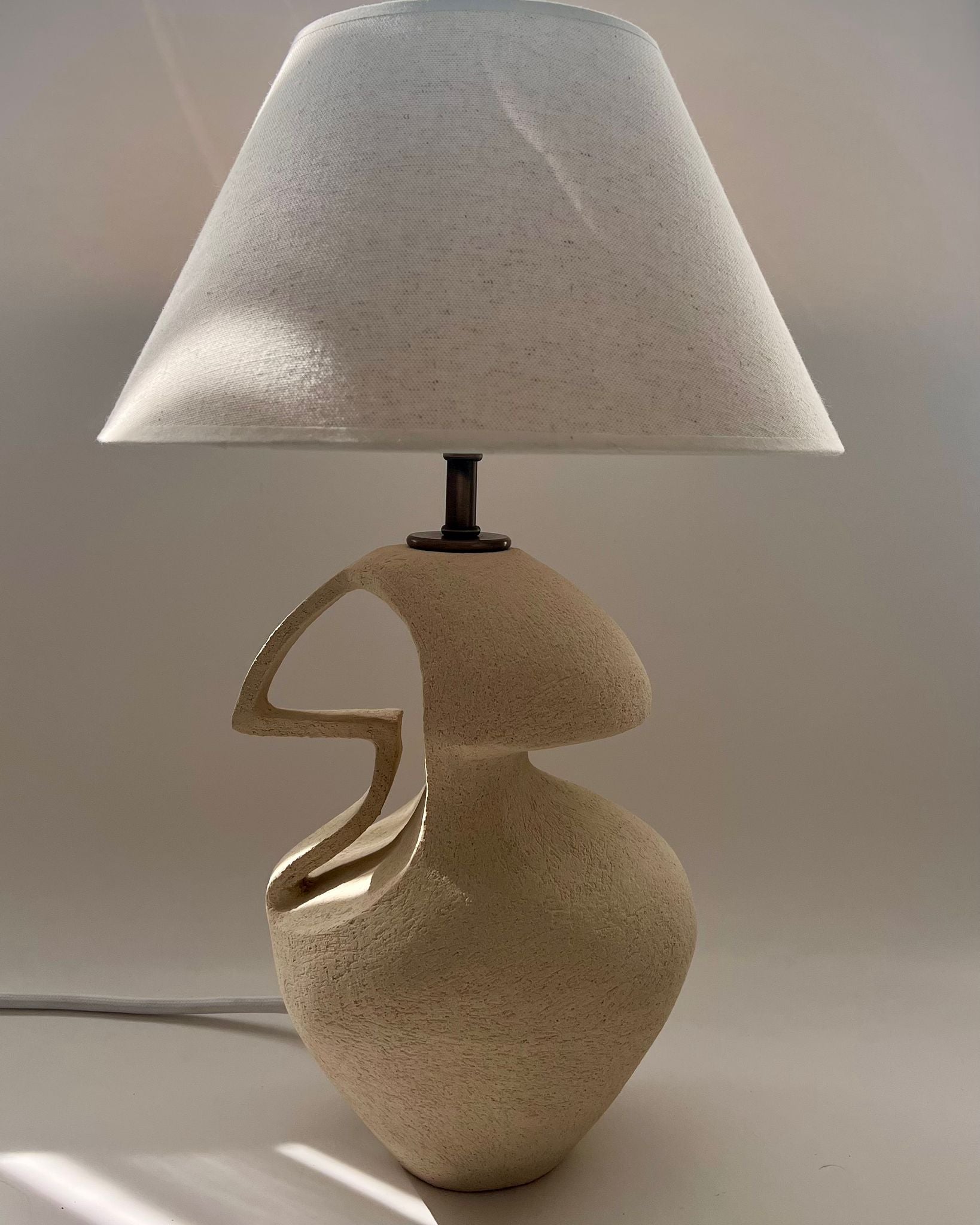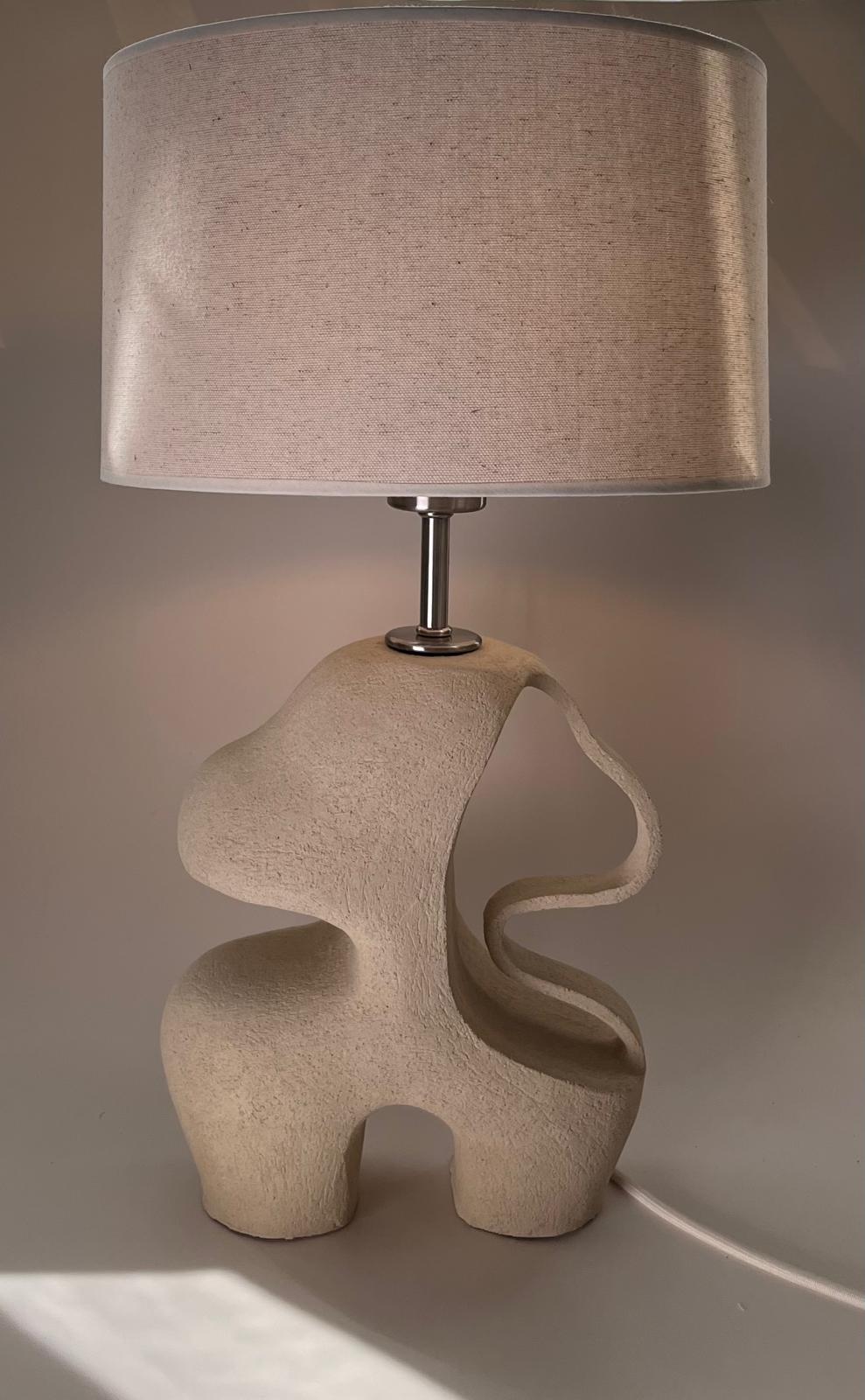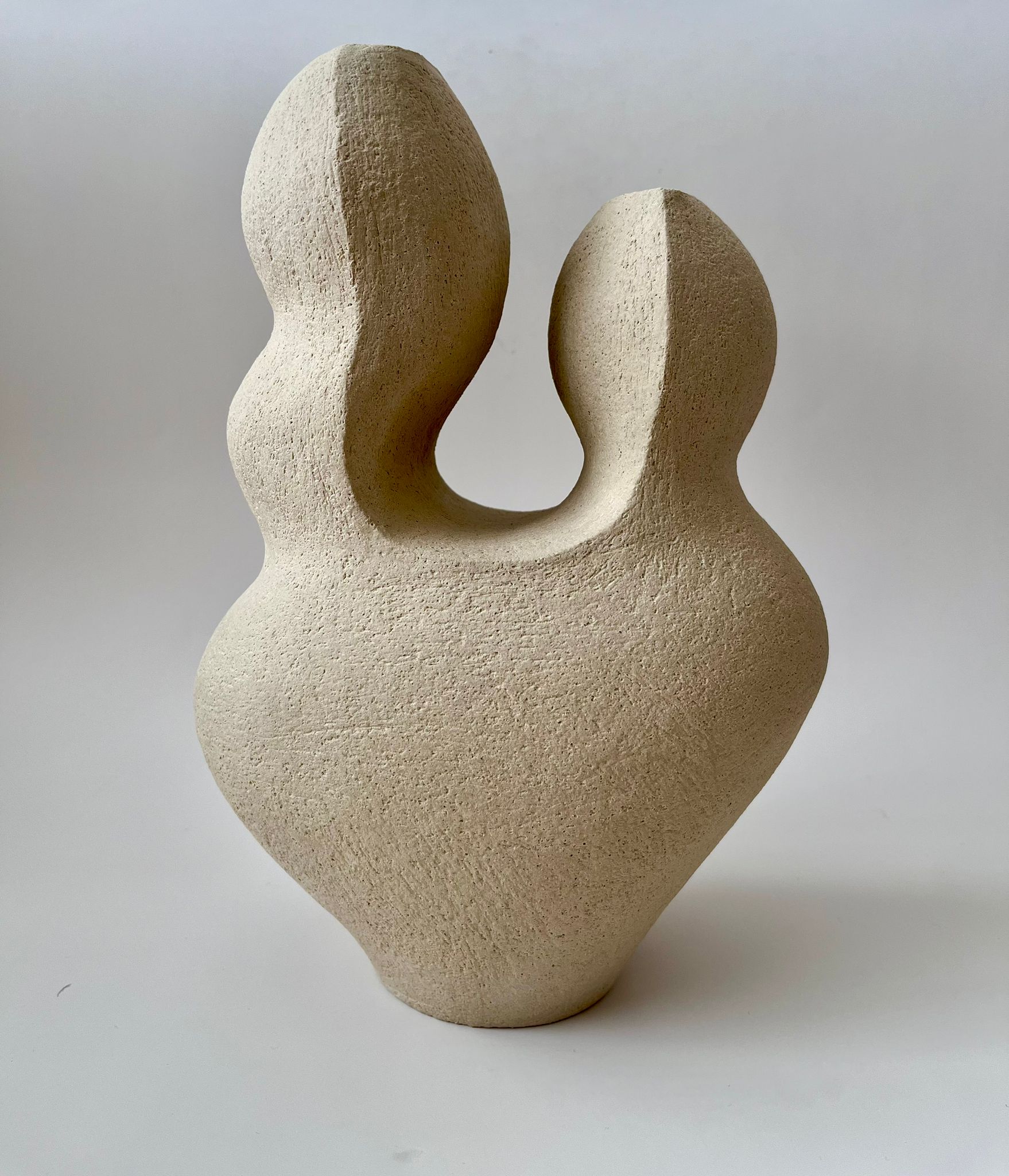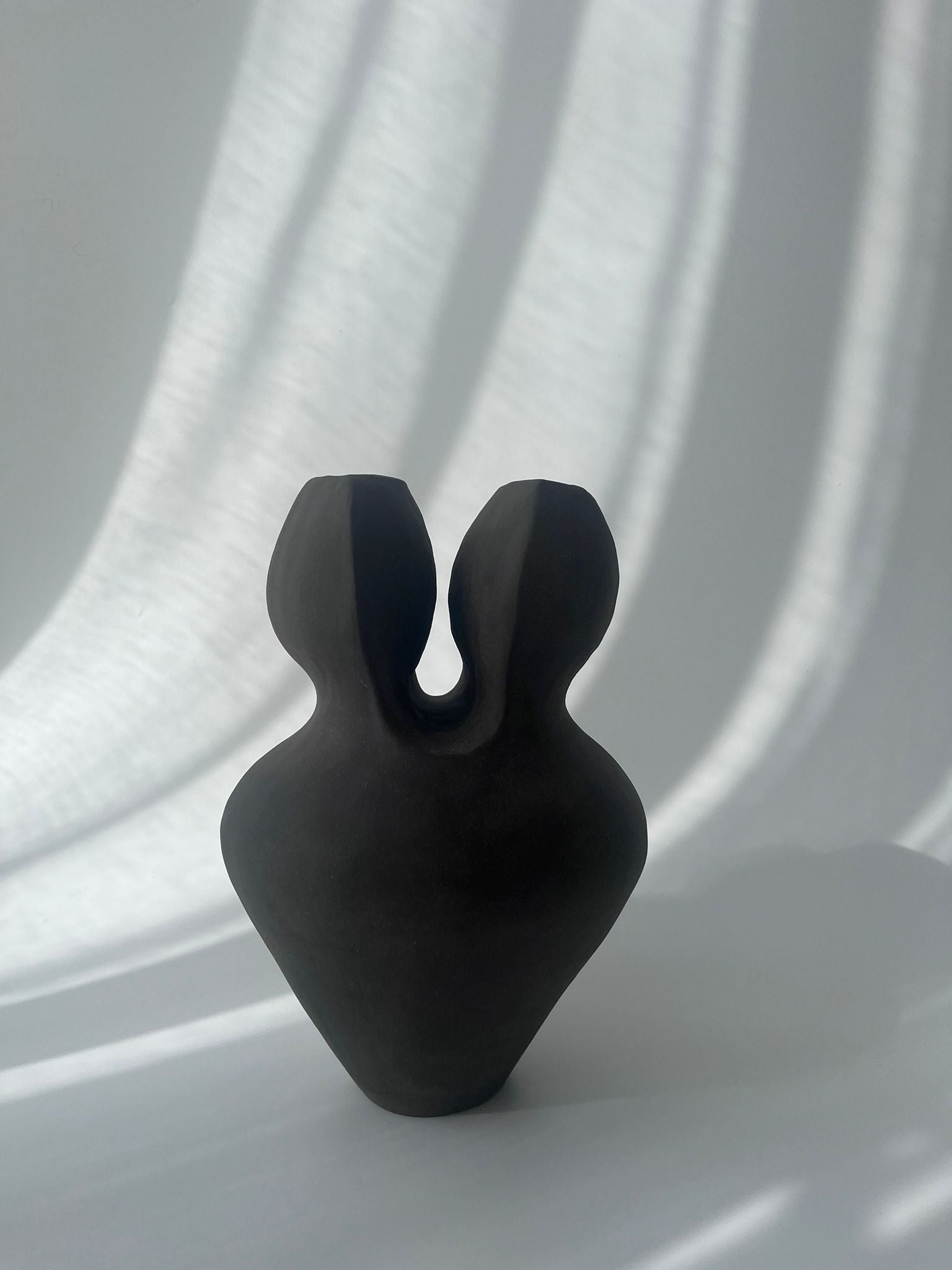Esra Misirli Kubilay: Master of Stoneware
Quiet Strength in Clay: Introducing Esra Misirli Kubilay
Some objects speak in whispers. They don’t try to dazzle; they invite you closer—asking you to notice the curve of a shoulder, the touch of a hand, the warmth of a surface shaped by time and intention. The stoneware of Esra Misirli Kubilay is made of these quiet invitations. In each piece, you sense an artist who honors both material and restraint, allowing clay to become a language of light, form, and tactility. For collectors seeking work that blends sculpture with function, the Esra Misirli Kubilay collection at Trove Gallery offers a considered journey into contemporary stoneware—anchored by lamps that turn light into atmosphere and vases that transform negative space into poetry.
Throughout this feature, we explore the philosophy that guides Esra’s practice, share styling guidance, and highlight four available works—two table lamps and two vases—that exemplify her mastery. If you’re looking to buy Esra Misirli Kubilay pieces that endure beyond trend, these works offer a refined path to living with art every day.
The Language of Stoneware: Material, Method, Meaning
Stoneware sits at the heart of Esra’s approach—high-fired, resolute, and quietly expressive. Unlike delicate earthenware or glassy porcelain, stoneware has a grounded presence. Fired at higher temperatures, it develops a dense body and nuanced surface that feels as honest as it looks. This material choice matters: it allows the artist to pursue restrained silhouettes while embracing the sensual variability of hand-applied finishes. Subtle shifts in color, softly broken edges, and a tactile grain all speak to process as much as to product.
In Esra Misirli Kubilay pottery, form isn’t embellished for effect; it’s distilled. Surfaces are often matte or softly lustrous—glazes that suggest a wabi-sabi sensibility where beauty emerges in quiet irregularities. The result is elegance without pretense, luxury defined not by opulence but by integrity. These are objects that feel as good as they look, intended to be used, lived with, and turned to in moments when a room needs a single, anchoring point of calm.
Collectors who favor minimalism will appreciate the discretion of Esra’s palette and profiles. Yet those who love expressive craftsmanship will find deep satisfaction in the evidence of the hand: a gentle ridge, a curve that narrows and releases, a base that bears the memory of its making. In the best sense, the artist stays in the work—not as a signature flourish, but as a presence.
Perspective and Practice: The Artist Behind the Work
To call Esra Misirli Kubilay an artist is to acknowledge how completely she bridges sculpture and utility. Each piece begins with the essential questions of proportion and balance: where does the eye rest, how does the object sit in space, and what does light do as it moves across the surface? Rather than chasing complication, she pursues precision. The forms feel architectural—weight placed where it matters, transitions managed with care—yet never severe. There’s a gentleness to the way edges soften and volumes relate, earning the description many of our collectors use: quiet strength.
In conversation with Trove Gallery, we often return to the idea of restraint. Restraint in palette. Restraint in line. Restraint in the number of pieces produced. This is slow work. Each lamp and vessel is given the time it requires—shaped, refined, and fired to bring forward the depth that only stoneware can hold. When you live with Esra’s pieces, you notice that they reward patience. Their presence grows over time, as you learn to see the small decisions that hold a form together.
For those searching for a collector’s introduction, the current series of lamps and vases offers an elegant entry point—works that showcase the breadth of the artist’s vocabulary while remaining deeply usable in the home.
Lighting as Sculpture: Table Lamp 6 and Table Lamp 7
Light changes everything. In Esra’s hands, a lamp isn’t simply a source of illumination; it’s a sculptural anchor that sets the tone for a room. Her stoneware bases carry the visual weight of an object with presence, allowing even soft light to feel intentional and composed.
Table Lamp 6 ($1,154.00) is the epitome of grounded elegance. Its silhouette reads as calm and assured—an organic profile that widens gently at the base for visual stability, then narrows in a measured rise that invites the eye upward. The surface carries the subtle character that stoneware is known for: variations in tone and texture that make the lamp feel alive in changing light. Placed on a credenza, bedside table, or reading nook, Table Lamp 6 creates a pool of warmth that softens edges and encourages slow moments.
By contrast, Table Lamp 7 ($1,154.00) presents a more vertical gesture—still restrained, but with a slim, poised lift. Where Lamp 6 leans toward a rounded, grounded character, Lamp 7 reads as architectural and refined, making it ideal for narrow consoles, paired end tables, or any space where height and clarity matter. Together, the two lamps demonstrate how the artist plays with proportion: how a slight adjustment in curve or shoulder can shift a piece’s emotional register from contemplative to quietly confident.
What unites both lamps is the way they treat light as material. During the day, their stoneware bases act as sculpture. At night, they become atmosphere—casting an intimate glow that harmonizes with textured walls, natural wood, or soft textiles. Whether your interior leans modern, transitional, or somewhere between, these lamps bring coherence without shouting for attention.
Styling note: For maximum effect, consider placing Table Lamp 6 near textural elements—linen, wool, or open-grain oak—to accentuate the lamp’s surface depth. Position Table Lamp 7 where its verticality can frame a vignette: a stack of books, a low ceramic bowl, or a framed artwork. Using warm, dimmable bulbs further enhances their sculptural presence.
Vessels as Architecture: Possibilities 1 and Possibilities 2
Great vessels are small architectures—spaces for breath, and for the eye to rest. Esra’s vessel forms are rooted in clarity: strong outlines and poised masses that feel both disciplined and poetic. The pieces in her Possibilities series suggest a dialogue between volume and void, inviting us to consider how negative space can be just as expressive as form.
Possibilities 1 Vase ($750.00) is a study in balance. A measured base gives way to a controlled ascent, where a subtle expansion yields a graceful shoulder. The result is a vessel that commands attention without dominating a room. Its stoneware surface, with natural variations and tactile richness, creates a shifting interplay of light and shadow as the day moves.
Possibilities 2 Vase ($750.00) complements its counterpart with a slightly different emphasis—perhaps a more pronounced taper or a nuanced lift that adds a note of lyricism. Displayed together, the two vases form a conversation in silhouette: one steady and grounding, the other slightly more kinetic. Each stands beautifully on its own; together they articulate a refined rhythm that brings cohesion to a shelf, console, or dining tableau.
How to live with them? Treat these vases as sculpture first. They can be displayed empty, where their surfaces and lines carry the composition. If you choose to add botanicals, consider simple branches, a few stems, or dried elements whose sparseness respects the vessel’s architecture. If adding water, a clear glass insert can be used as a liner to preserve the finish over time.
How to Style and Care: Making Space for Stoneware
Esra’s work thrives in rooms that value ease and intention. Think layered neutrals, honest textures, and curated restraint. Here are a few guiding ideas for integrating these stoneware pieces into your home:
For the lamps, group with objects that share a material sensibility—wood, natural fiber, honed stone. Let the lamp base read clearly against a calm backdrop; avoid overly busy surfaces that compete with its form. In entryways, a single lamp paired with a low bowl and a beloved book creates a welcoming ritual. In the bedroom, a lamp on each bedside builds symmetry while keeping the atmosphere soft and restful.
For the vases, use negative space as a design element. On a long shelf, place the vessel off-center and allow open air to do part of the visual work. On a dining table, a single vase can replace florals entirely—an approach that reduces visual noise and keeps your table’s surface serene between gatherings.
Care is straightforward: dust with a soft, dry cloth and avoid abrasive cleaners that can dull the finish. If needed, a barely damp cloth can lift surface dust; always dry promptly. When moving heavy stoneware, support from the base rather than lifting by the neck. Felt pads beneath lamp or vase bases can protect delicate surfaces. For lamps, warm, dimmable bulbs emphasize the depth of the ceramic surface and create a more inviting glow.
Collecting with Intention: Why Esra’s Work Endures
To collect is to edit—choosing the few objects that earn their place and remain meaningful. The appeal of Esra Misirli Kubilay’s work lies in its longevity. These pieces don’t rely on trend or ornament; they rely on proportion, material integrity, and touch. That’s why they integrate so seamlessly into a range of interiors, from modern lofts to understated countryside homes. They hold their own in quiet rooms and offer restfulness in energetic ones.
For new collectors, the lamps are an ideal entry point—functional objects that shift the mood of a space every evening. The vases will appeal to those who see their home as a gallery of daily life, where a single form can recalibrate a room. For seasoned collectors, pairing a lamp with a vessel strengthens the narrative: light and form, utility and sculpture, gathered into a cohesive collection.
At Trove Gallery, we curate pieces that honor both maker and material. The Esra Misirli Kubilay artist page brings together her latest works, with availability updated in real time. As with all handmade objects, slight variations are part of the beauty—what you receive bears the unique fingerprint of its making.
If you’re searching specifically to buy Esra Misirli Kubilay pottery that balances sculpture and function, consider starting with one of these four featured pieces:
• Table Lamp 6 ($1,154.00): Grounded, contemplative, quietly luxurious.
• Table Lamp 7 ($1,154.00): Poised, vertical, architecturally refined.
• Possibilities 1 Vase ($750.00): Balanced silhouette, tactile depth.
• Possibilities 2 Vase ($750.00): Complementary profile, sculptural presence.
Each is a compelling entry into the broader Esra Misirli Kubilay collection and an invitation to build a cohesive, personal vocabulary of form and texture at home.
Bring the Work Home
Great design doesn’t raise its voice; it refines the conversation in a room. Esra Misirli Kubilay’s stoneware does exactly that—shaping light, grounding space, and inviting touch. Whether you’re drawn to the assured calm of a lamp or the architectural clarity of a vessel, the pieces featured here are ready to anchor your daily rituals.
Explore the full selection on the Esra Misirli Kubilay collection page, or go directly to the works highlighted in this feature: Table Lamp 6, Table Lamp 7, Possibilities 1 Vase, and Possibilities 2 Vase. If you’re ready to buy Esra Misirli Kubilay pieces that elevate every day, Trove Gallery is honored to place them in your care.



